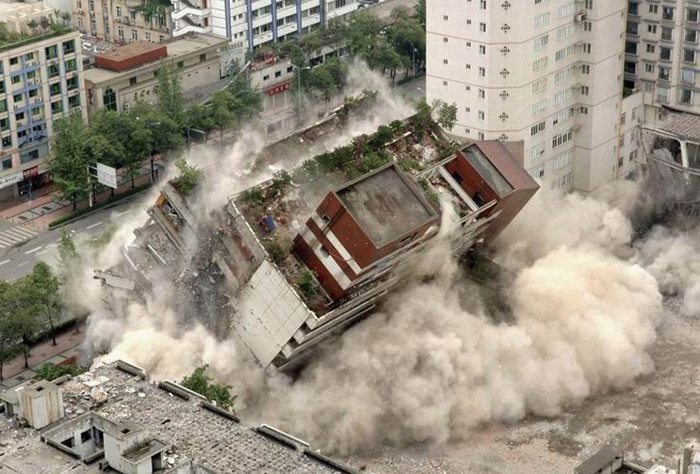Proper planning and execution makes all the difference
Bringing a tall steel-framed building down into their footprints is a considerable engineering feat since it necessitates overcoming the natural tendency of such structures to topple.The demolition project can therefore be a huge undertaking, requiring a great deal of pre-planning in order to coordinate all facets of the project. Through the course of the project some detours and changes will inevitably occur, but a solid plan and direct course of activities will assist in minimizing the overall impact on project schedule, cost and liabilities.
Planning Stages
If the intended use of the site is known, it is helpful to make the contractor aware of that information. The contractor’s expertise and input at this stage of the project can help with the projects success. Determining if the demolition contractor will carry the cost and responsibility of utility disconnections is key at this stage. If not, the owner should provide all disconnect documentation to the demolition contractor.
If material from the project are to be reused, the contractor should be made aware as early as possible. The ownership of the salvaged materials should be made clear and the extent of underground removals should be clearly defined. Any hazardous materials should be determined and whether they will have environmental remediation completed by the demolition contractor or by a separate entity. Permits should be secured, alternatively it should be made clear as to which party will secure permits.
In addition, expected conditions of site at completion of demolition should be clear and conveyed to the contractor prior to the commencement of the task.
The key issues during the planning phase to be taken care of as part of the planning process include fall from height, injury from fall materials, uncontrolled collapse, risks from connected services, traffic management, hazardous materials, noise and vibration, fire and worker involvement during the process of demolition.
Demolition Technologies
Demolition technologies have continued to evolve over the years in order ensure increased efficiency, cost effectiveness, improved safety.
From conventional mechanical methods to pneumatic and hydraulic tools, non-explosive demolition, controlled explosives as well as remote controlled demolition systems, minimizing the overall impact on project schedule, cost and liabilities should be the top priority of the method chosen.
Controlled Explosive Demolition Techniques
Where space and conditions permit, it is often best to use controlled explosive methods as the primary demolition technique for large, tall structures, with mechanical methods used for secondary demolition of the structure and subsequent processing of the debris.
In such situations the controlled use of explosives is supremely superior to any other form of demolition, both in terms of safety and speed, as well as efficiency.
It is accomplished in conventional controlled demolitions by the synchronised detonation of numerous small explosive charges, placed adjacent to support columns throughout the building. Through precise timing of the detonations of the hundreds or thousands of explosive packages, interior structures are destroyed ahead of exterior ones, pulling the exterior walls toward the central axis in a classic controlled demolition implosion.
Presumably the detonations throughout the interior or exterior could be simultaneous, or marched up the building as it sinks into its footprint.
Mechanical Methods
Mechanical demolition involves both the pulling down and the knocking down of the structure by machines. Mechanical demolition uses such machinery as bulldozers, cranes, and excavators, while larger structures involve wrecking balls.
These methods are normally top down methods where the demolition starts from top floor and proceeds towards the ground. For structural projections, such as balconies, canopies and verandas extending beyond the building lines, demolition by hand held tools or the cut and lift process may be a safe solution.
Computerized Demolition
Use of computers and radio links is one of the systems that could facilitate the ease of deployment and operational flexibility of a scheme employing numerous individual explosives to destroy the building from the crash zone downward. Packages of explosives are installed on nearly every floor. Each package would have a battery powered radio link that connects it to the main computer, and it will be able to detonate a specific package of explosives at specific times simply by sending signals to the packages.
High-Tech Demolition Systems
These are safe and environmental friendly methods developed in Japan, and have been used in the demolition of the 40- storey building located near Akasaka, Tokyo. The demolition system is called the ‘Taisei Ecological Reproduction System’- (Tecorep System). Under the conventional system a building is destroyed from the top down with roofless top left open. The Tocorep system keeps the building as open enclosed space, retaining the roof of the top floor for cover. The outer circumference of the top floor is covered with soundproof panels so that noise and flying dust can be minimized.
Quake-proof Demolition Method
Unlike the Tecorep System that dismantles building from top down, another demolition process, dubbed the “Kajima Cut and Take down Method,” has been developed to break buildings from bottom up for the first time in the world. Under this method, the shape of a building can be very much intact. The method is attracting a lot of attention because all dismantling work is conducted underground, resulting in not only reducing noise and dust but also dramatically improving the rate of recycling disassembled materials.
In spite of the challenges facing the demolition industry, a number of companies have continued with the quest to improve and make the process as environmental friendly as possible, minimising the direct exposure of employees to hazards of demolition as far as practical. In-house and imported design of specialised demolition equipment has assisted in meeting the versatility and durability requirements of the demanding demolition process.
The systematic approach to demolition projects is a team effort involving a number of people who have the responsibilities to make sure that the process is executed according to the plan. Whatever, explosive, mechanical tool and method, or demolition contractor is chosen- improved safety, increased speed and cost savings for the project are key.

